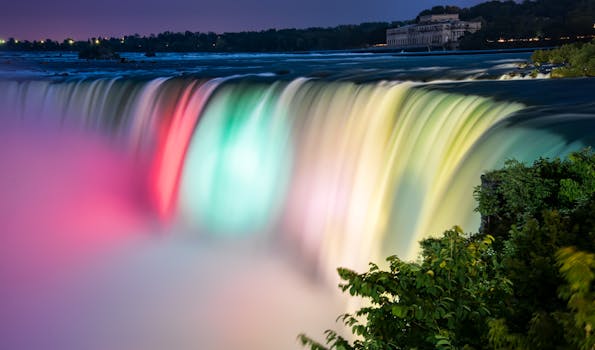The Majestic Waterfalls of South America

South America is home to some of the most awe-inspiring waterfalls in the world. From the mighty Iguazu Falls straddling the border of Argentina and Brazil to Venezuela's Angel Falls, the tallest uninterrupted waterfall globally, the continent boasts an array of natural wonders that draw millions of visitors annually. These waterfalls are not just spectacular sights but also vital ecosystems supporting diverse flora and fauna.
Iguazu Falls: A Natural Wonder
Iguazu Falls, located on the border between Argentina and Brazil, is a UNESCO World Heritage site and one of the New Seven Wonders of Nature. Spanning nearly 2.7 kilometers, this colossal waterfall system consists of 275 individual falls. The most famous section, the Devil's Throat (Garganta del Diablo), drops 80 meters with such force that it creates a permanent mist visible from miles away.
Visitors can explore both sides of the falls, each offering unique perspectives. The Argentine side provides an immersive experience with numerous walking trails and boat rides that get you up close to the falls. In contrast, the Brazilian side offers panoramic views that showcase the falls' grandeur.
- Argentine Side: Walkways, Boat Rides
- Brazilian Side: Panoramic Views
The local flora and fauna are equally captivating. The surrounding rainforest is home to over 2,000 plant species and a plethora of wildlife, including jaguars, howler monkeys, and colorful butterflies.
Angel Falls: The World's Tallest Waterfall
Located in Venezuela's Canaima National Park, Angel Falls plunges 979 meters from Auyán-Tepuí mountain, making it the world's tallest uninterrupted waterfall. Named after American aviator Jimmie Angel who discovered it in 1933, this remote waterfall is accessible only by air or riverboat.
Reaching Angel Falls involves a journey through dense jungle and winding rivers. Once there, visitors are rewarded with breathtaking views of water cascading down sheer cliffs into a series of pools below. The falls are most impressive during the rainy season (May to November) when water flow is at its peak.
The surrounding Canaima National Park is a UNESCO World Heritage site known for its unique table-top mountains called tepuis. These ancient geological formations are considered some of the oldest on Earth, dating back over two billion years.
Kaieteur Falls: Guyana's Hidden Gem
Kaieteur Falls in Guyana is one of South America's lesser-known yet equally magnificent waterfalls. With a single drop of 226 meters, it is nearly five times higher than Niagara Falls. Located in Kaieteur National Park, this waterfall is surrounded by pristine rainforest teeming with biodiversity.
Unlike other major waterfalls in South America, Kaieteur Falls remains relatively untouched by tourism. This isolation adds to its charm, offering visitors a more intimate experience with nature. Guided tours typically include a scenic flight over the falls followed by a hike through the lush rainforest.
| Waterfall | Country | Height (meters) | Notable Features |
|---|---|---|---|
| Iguazu Falls | Argentina/Brazil | 80 (Devil's Throat) | UNESCO World Heritage Site |
| Angel Falls | Venezuela | 979 | Tallest Uninterrupted Waterfall |
| Kaieteur Falls | Guyana | 226 | Lesser-Known Natural Wonder |
The Cultural Significance of Waterfalls in South America
Waterfalls in South America are deeply embedded in local cultures and traditions. Indigenous communities often regard these natural wonders as sacred sites imbued with spiritual significance. For instance, the Guarani people believe Iguazu Falls were created by a deity as part of a myth involving love and betrayal.
These cultural narratives add another layer of richness to visiting these waterfalls. Understanding their historical and cultural contexts enhances appreciation for these natural wonders beyond their physical beauty.
Sustainable Tourism Practices Around Waterfalls
Sustainable tourism practices are crucial for preserving South America's majestic waterfalls and their surrounding ecosystems. Over-tourism can lead to habitat destruction, pollution, and disruption of local wildlife.
Efforts are being made to promote eco-friendly tourism around these sites. For example:
- Iguazu Falls: Strict visitor regulations and eco-friendly infrastructure to minimize environmental impact.
- Angel Falls: Limited access points to control tourist numbers and reduce ecological footprint.
- Kaieteur Falls: Guided tours emphasizing conservation education and low-impact travel methods.
Sustainable tourism practices help ensure that these natural wonders remain intact for future generations to experience and enjoy.
The majestic waterfalls of South America offer more than just stunning vistas; they are vital ecosystems teeming with biodiversity and rich cultural significance. From Iguazu Falls' immense power to Angel Falls' towering height and Kaieteur Falls' secluded beauty, each waterfall provides a unique experience that captivates visitors from around the world.